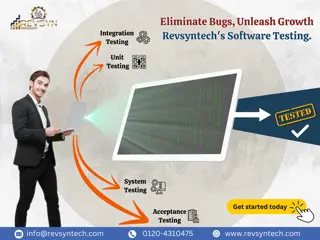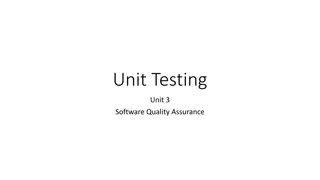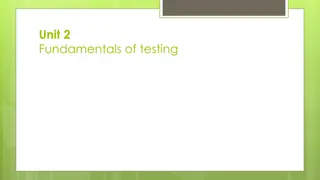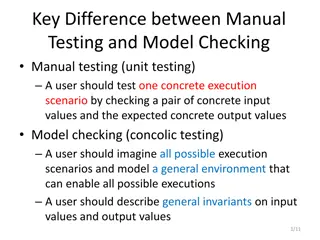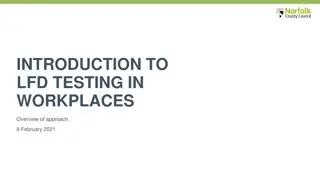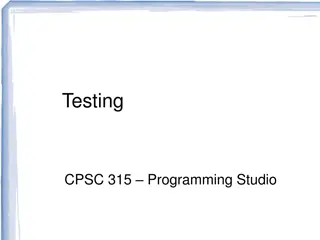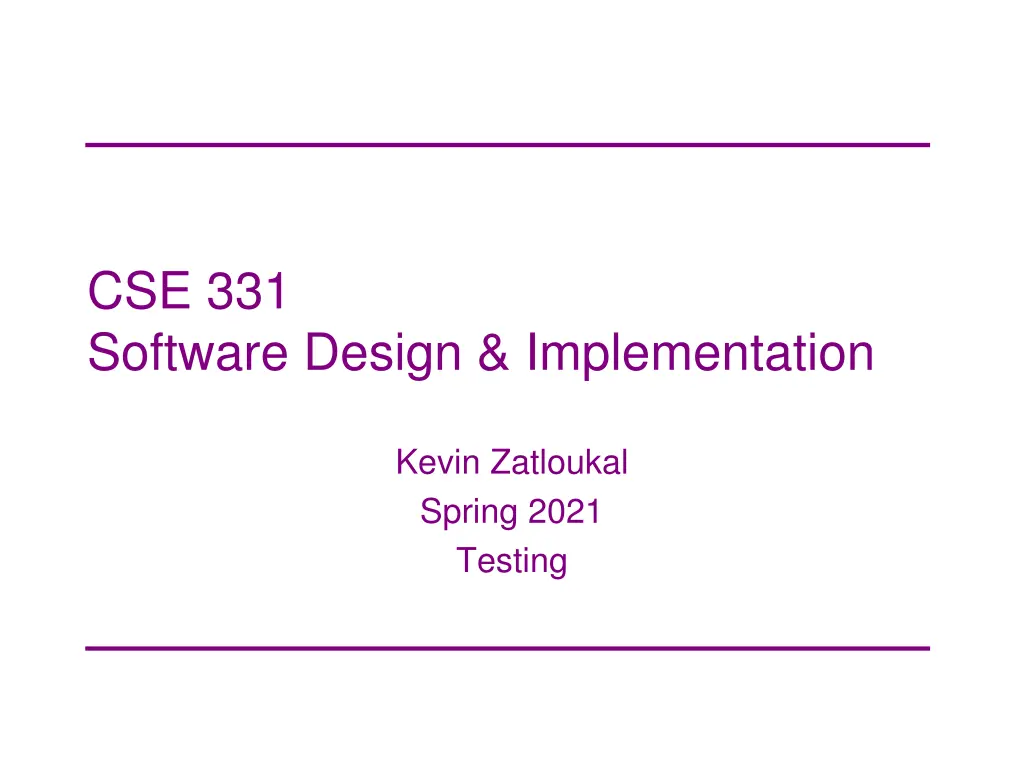
Software Testing Heuristics
Explore different testing heuristics such as specification-based testing, clear-box testing, and combining clear and black-box testing to ensure effective bug detection. Learn how to split input spaces, choose subdomains, write tests based on specification cases, and focus on features not described by specifications. Understand the significance of revealing subdomains in testing processes.
Download Presentation

Please find below an Image/Link to download the presentation.
The content on the website is provided AS IS for your information and personal use only. It may not be sold, licensed, or shared on other websites without obtaining consent from the author. If you encounter any issues during the download, it is possible that the publisher has removed the file from their server.
You are allowed to download the files provided on this website for personal or commercial use, subject to the condition that they are used lawfully. All files are the property of their respective owners.
The content on the website is provided AS IS for your information and personal use only. It may not be sold, licensed, or shared on other websites without obtaining consent from the author.
E N D
Presentation Transcript
CSE 331 Software Design & Implementation Kevin Zatloukal Spring 2021 Testing
Testing Heuristics Testing is essential but difficult want set of tests likely to reveal the bugs present but we don t know where the bugs are Our approach: split the input space into enough subsets (subdomains) such that inputs in each one are likely all correct or incorrect think carefully through the subdomains you are using can then take just one example from each subdomain Some heuristics are useful for choosing subdomains... CSE 331 Spring 2021 2
Specification Testing Heuristic: Explore alternate cases in the specification Procedure is a black box: specification visible, internals hidden Example // returns: a > b => returns a // a < b => returns b // a = b => returns a int max(int a, int b) { } 3 cases lead to 3 tests (4, 3) => 4 (i.e. any input in the subdomain a > b) (3, 4) => 4 (i.e. any input in the subdomain a < b) (3, 3) => 3 (i.e. any input in the subdomain a = b) CSE 331 Spring 2021 3
Specification Testing Example Write tests based on cases in the specification // returns: the smallest i such // that a[i] == value // throws: Missing if value is not in a int find(int[] a, int value) throws Missing Two obvious tests: ( [4, 5, 6], 5 ) => 1 ( [4, 5, 6], 7 ) => throw Missing Have we captured all the cases? ( ( ) ) = = Must hunt for multiple cases Including scrutiny of effects and modifies CSE 331 Spring 2021 4
Heuristic: Clear (glass, white)-box testing Focus on features not described by specification control-flow details (e.g., conditions of if statements in code) performance optimizations alternate algorithms for different cases CSE 331 Spring 2021 5
Combining Clear- and Black-Box For buggy abs, what are revealing subdomains? // returns: x < 0 => returns x // otherwise => returns x int abs(int x) { if (x < -2) return -x; else return x; } Example sets of subdomains: Which is best? {-2} {-1} {0} {1} { , -4, -3} {-2, -1} {0, 1, } { ,-6, -5, -4} {-3, -2, -1} {0, 1, 2, } Why not: CSE 331 Spring 2021 6
Heuristic: Boundary & Special Cases Create tests at the edges of subdomains Why? Off-by-one bugs Empty cases (0 elements, null, ) Overflow errors in arithmetic Object aliasing Small subdomains at the edges of the main subdomains have a high probability of revealing many common errors also, you might have misdrawn the boundaries CSE 331 Spring 2021 7
Boundary Testing Point is on a boundary if either: there exists an adjacent point in a different subdomain there is no point to one side Example: function has different behavior on n and n+1 CSE 331 Spring 2021 8
Boundary Cases: Integers // returns: |x| public int abs(int x) { } What are some values or ranges of x that might be worth probing? x < 0 (flips sign) or x 0 (returns unchanged) Around x = 0 (boundary condition) Specific tests: say x = -1, 0, 1 CSE 331 Spring 2021 9
Boundary Testing To define the boundary, need a notion of adjacent inputs Example approach: identify basic operations on input points two points are adjacent if one basic operation apart Point is on a boundary if either: there exists an adjacent point in a different subdomain some basic operation cannot be applied to the point Example: list of integers basic operations: create, append, set, remove adjacent points: <[2,3],[2,4]>, <[2,3],[2,3,3]>, <[2,3],[2]> boundary point: [ ] (can t apply remove) CSE 331 Spring 2021 10
Heuristic: Special Cases Arithmetic smallest/largest values zero Objects null list containing itself maybe a bit too pathological same object passed as multiple arguments (aliasing) All of these are common cases where bugs lurk you ll find more as you encounter more bugs CSE 331 Spring 2021 11
Special Cases: Arithmetic Overflow // returns: |x| public int abs(int x) { } How about int x = Integer.MIN_VALUE; // x=-2147483648 System.out.println(x<0); // true System.out.println(Math.abs(x)<0); // also true! From Javadoc for Math.abs: Note that if the argument is equal to the value of Integer.MIN_VALUE, the most negative representable int value, the result is that same value, which is negative CSE 331 Spring 2021 12
Special Cases: Duplicates & Aliases // modifies: src, dest // effects: removes all elements of src and // appends them in reverse order to // the end of dest <E> void appendList(List<E> src, List<E> dest) { while (src.size() > 0) { E elt = src.remove(src.size() - 1); dest.add(elt); } } What happens if src and dest refer to the same object? this is aliasing it s easy to forget! watch out for shared references in inputs CSE 331 Spring 2021 13
sqrt example // throws: IllegalArgumentException if x<0 // returns: approximation to square root of x public double sqrt(double x){ } What are some values or ranges of x that might be worth probing? x < 0 (exception thrown) x 0 (returns normally) around x = 0 (boundary condition) perfect squares (sqrt(x) an integer), non-perfect squares x<sqrt(x) and x>sqrt(x) that's x<1 and x>1 (and x=1) Specific tests: say x = -1, 0, 0.5, 1, 4 (probably want more) CSE 331 Spring 2021 14
How many tests is enough? Correct goal should use revealing subdomains: one from the middle of each subdomain examples along the boundaries of each subdomain CSE 331 Spring 2021 15
How many tests is enough? Common goal is to achieve high code coverage: ensure test suite covers (executes) all of the program assess quality of test suite with % coverage tools to measure this for you Assumption implicit in goal: if high coverage, then most mistakes discovered far from perfect but widely used low code coverage is definitely bad CSE 331 Spring 2021 16
Code coverage: statement coverage int min(int a, int b) { int r = a; if (a <= b) { r = a; } return r; } Consider any test with a b (e.g., min(1,2)) executes every instruction misses the bug Statement coverage is not enough CSE 331 Spring 2021 17
Code coverage: branch coverage int quadrant(int x, int y) { int ans; if (x >= 0) ans=1; else ans=2; if (y < 0) ans=4; return ans; } 2 1 3 4 Consider two-test suite: (2,-2) and (-2,2). Misses the bug. Branch coverage(all tests go both ways ) is not enough here, path coverage is enough (there are 4 paths) CSE 331 Spring 2021 18
Code coverage: path coverage int countPositive(int[] a) { int ans = 0; for (int x : a) { if (x > 0) ans = 1; // should be ans += 1; } return ans; } Consider two-test suite: [0,0] and [1]. Misses the bug. Or consider one-test suite: [0,1,0]. Misses the bug. Path coverage is enough, but no bound on path-count! CSE 331 Spring 2021 19
Code coverage: what is enough? int sumOfThree(int a, int b, int c) { return a+b; } Path coverage is not enough consider test suites where c is always 0 Typically a moot point since path coverage is unattainable for realistic programs but do not assume a tested path is correct even though it is more likely correct than an untested path Another example: buggy abs method from earlier in lecture CSE 331 Spring 2021 20
Varieties of coverage Various coverage metrics (there are more): Statement coverage Branch coverage Loop coverage Condition/Decision coverage Path coverage increasing number of test cases required (generally) Limitations of coverage: 1. 100% coverage is not always a reasonable target may be high cost to approach 100% 2. Coverage is just a heuristic we really want the revealing subdomains for the errors present CSE 331 Spring 2021 21
Summary of Heuristics Split subdomains on boundaries appearing in the specification Split subdomains on boundaries appearing in the implementation Test boundaries that commonly lead to errors Test special cases like nulls, empty arrays, 0, etc. Tests to exercise every branch of the code all paths would be even nicer (but not always possible) Test any cases that caused bugs before (to avoid regression) On the other hand, don't confuse volume with quality of tests look for revealing subdomains want tests in every revealing subdomain not just lots of tests CSE 331 Spring 2021 22
Testing Tools Modern development ecosystems have built-in support for testing Your homework introduces you to Junit standard framework for testing in Java Continuous integration ensure tests pass before code is submitted You will see more sophisticated tools in industry libraries for creating mock implementations of other modules automated tools to test on every platform automated tools to find severe bugs (using AI) CSE 331 Spring 2021 23
Testing Tips Write tests both before and after you write the code (only clear-box tests need to come afterward) Be systematic: think through revealing subdomains & test each one Test your tests try putting a bug in to make sure the test catches it Test code is different from regular code changeability is less important; correctness is more important do not write any test code that is not obviously correct otherwise, you need to test that code too! unlike in regular code, it s okay to repeat yourself in tests CSE 331 Spring 2021 24

